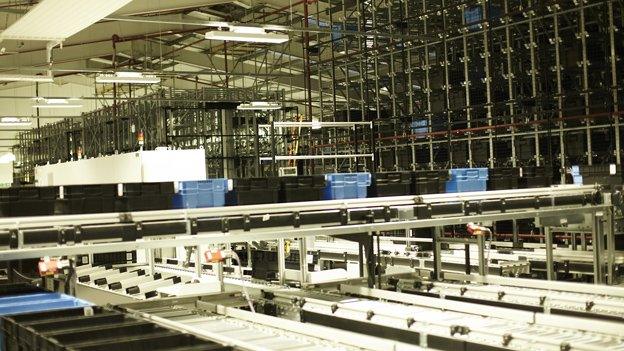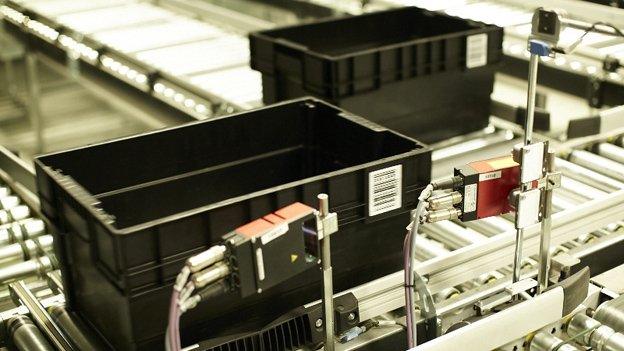Logistics: Rise of the warehouse robots
- Published

Strength in numbers? Santa has his elves - but big retailers looking to compete are adopting innovative robotic technology
"When I came to this business in 2003, the day I arrived we had 60 orders that day and the girls in the packing room were in tears - how were they going to get 60 orders out in one day? Now we are getting thousands and thousands out in a day"
For Net-A-Porter chief executive Mark Sebba this is the busiest time of the year. The company sells high-end fashion online.
At the heart of all e-commerce operations lies the warehouse, and the process of picking products to fill customer orders.
"The most important person in the whole chain is the customer," says Mr Sebba.
"If we don't focus on the customer, then we're lost. So what does the customer want? The customer wants an absolutely impeccable service and she or he wants the product really as soon as she or he can possibly get it."
When your company is selling to the world from distribution centres based in London and New York (and soon Hong Kong) - and you don't have the benefit of a non-union 24/7 elf workforce - what's the answer?
For Net-A-Porter it was automating the process with vast banks of robot pickers.
Pick me
Hidden away in an industrial estate, bordering a slightly down-at-heel area of south London, is a collection of non-descript industrial units surrounding a small cul-de-sac.

Pick'n'mix: At Net-A-Porter's warehouse the robot picker (centre) races up the aisles up speeds of up to 30mph
The only clue as to what lies inside is a huddle of small, black vans with the words 'Net-A-Porter' picked out in white.
Once inside you realise this is a fashion retailer, with white walls and minimalist fittings, and a meeting room complete with chandelier looking out towards the robot pickers.
In the clean and surprisingly warm warehouse, vast towers of black boxes are stacked side by side.
In between the robots swish up and down, packing new products away or selecting boxes - or totes - and delivering them to a conveyor belt.

On the conveyor belt: From the pickers the goods - in plastic boxes called totes - are sent to be sorted into orders
"As the business grows and volumes increase and capacity becomes paramount, it lends itself to introduce automation into a facility," says Bill Duffy, global director of operations.
"And particularly in a building such as this where you have very high ceilings, it's very important to us to take advantage of the full cube of the facility, the height, as well as the depth and width for the storage of the product."
The company responsible for customising the robot picking system is logistics specialists TGW, whose engineers are on site 24/7 to make sure nothing slows the process down. The cranes can move at speeds of up to 30mph, picking and packing simultaneously.
Bow to the inevitable
This is about as far from the uncanny valley, external as it's possible to be - and it is this type of robotic technology that is becoming ubiquitous in industry, rather than the replicants of Blade Runner, external.

Following on: All stock and totes are tracked via easily scannable barcodes
The pickers are integrated into Net a Porters own stock tracking and distribution system, which was developed in-house.
Orders are taken on the website, and the information relayed via the stock system to the robot pickers. Goods are picked and delivered to people to on the floor above. The system directs how the orders need to be put together using a simple light and switch system, and then the goods proceed for packing, with every item being tracked via barcode.
According to Mr Duffy, the whole process - or pick rate - is over 500% faster.

Human touch: Some things, like the packing process, still require a little human care
The system currently deals only with flat goods - items that don't require hanging. But that is set to change, with a semi-automated system to deal with goods on hangers (GOH) about to start construction.
This type of automation was inevitable, says Mark Sebba.
"The growth of the business would not have been possible without the automation, but I didn't see the automation leading the growth of the business.
"I see the automation fulfilling the growth requirements."
Robot takeover
Manual picking is a labour intensive - and sometimes controversial, external - business. But investing in robotic systems is expensive, and can set you back millions rather than thousands of pounds.
Amazon solved their automation problems by going out and buying their own manufacturer - Kiva Systems - for the slightly heftier price tag of $775m.
How parcels get from web to front door
While isn't something to think about while operating your eBay shop front from your garage, you don't have to be a multinational giant.
Autostore is a system designed to grow incrementally. Instead of banks of boxes, stock is held in a vertical grid system, with robots running across the top on rails.
The system works out what is most in demand, and holds that at the top of the stack, with the least sought after at the bottom.
The robots at the top of the grid look ahead and work out the best way to access stock, digging down and arranging boxes as efficiently as possible.

Grid lines: Autostore's robots run around on top of a giant metal grid, pulling products up from inside
Swisslog's James Sharples says the system should result in a 40-50% reduction in floor space needed for storage, as well as other benefits.
"There is a productivity benefit in terms of the pick rates that people would achieve within a manual warehouse," he says.
"Normally that involves a lot of walking. You are having to go from one location to the next location to the next location.
"And the productivity rate you achieve, the number of items somebody would pick per hour can be limited because really half the time they are walking."
Companies using the system include retailers Asda and Ocado, and Swiss paper and packaging material distributor Antalis.
Meanwhile research continues apace.
In Germany, the Fraunhofer Institute is working on a project to develop autonomous warehouse vehicles using the movement of ants, external.
This "swarm intelligence" means the robots themselves will decide how to move around the space to best efficiency.
For those looking at embracing the rise of the robotic warehouse, Net-A-Porter's Bill Duffy has some advice.
"Do your homework. Because there are different degrees of expertise. And that partner you choose, is a very costly investment, and you plan it - you're getting married to that partner," he says.
"That technology you've invested in is for the long-term and when things need to be adjusted, enhanced, expanded, you got to go back to the same guy. It's very hard to integrate a new player into existing technology."
Correction: The piece was amended later to make more clear the role played by TGW in customising a bespoke use for the robot picking technology.